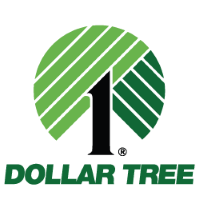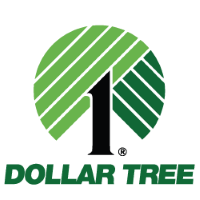
Dollar Tree Inc
NASDAQ:DLTR


| US |

|
Johnson & Johnson
NYSE:JNJ
|
Pharmaceuticals
|
| US |

|
Berkshire Hathaway Inc
NYSE:BRK.A
|
Financial Services
|
| US |

|
Bank of America Corp
NYSE:BAC
|
Banking
|
| US |

|
Mastercard Inc
NYSE:MA
|
Technology
|
| US |

|
UnitedHealth Group Inc
NYSE:UNH
|
Health Care
|
| US |

|
Exxon Mobil Corp
NYSE:XOM
|
Energy
|
| US |

|
Pfizer Inc
NYSE:PFE
|
Pharmaceuticals
|
| US |

|
Palantir Technologies Inc
NYSE:PLTR
|
Technology
|
| US |

|
Nike Inc
NYSE:NKE
|
Textiles, Apparel & Luxury Goods
|
| US |

|
Visa Inc
NYSE:V
|
Technology
|
| CN |

|
Alibaba Group Holding Ltd
NYSE:BABA
|
Retail
|
| US |

|
3M Co
NYSE:MMM
|
Industrial Conglomerates
|
| US |

|
JPMorgan Chase & Co
NYSE:JPM
|
Banking
|
| US |

|
Coca-Cola Co
NYSE:KO
|
Beverages
|
| US |

|
Walmart Inc
NYSE:WMT
|
Retail
|
| US |

|
Verizon Communications Inc
NYSE:VZ
|
Telecommunication
|
Utilize notes to systematically review your investment decisions. By reflecting on past outcomes, you can discern effective strategies and identify those that underperformed. This continuous feedback loop enables you to adapt and refine your approach, optimizing for future success.
Each note serves as a learning point, offering insights into your decision-making processes. Over time, you'll accumulate a personalized database of knowledge, enhancing your ability to make informed decisions quickly and effectively.
With a comprehensive record of your investment history at your fingertips, you can compare current opportunities against past experiences. This not only bolsters your confidence but also ensures that each decision is grounded in a well-documented rationale.
Do you really want to delete this note?
This action cannot be undone.

| 52 Week Range |
61.21
150.02
|
| Price Target |
|
We'll email you a reminder when the closing price reaches USD.
Choose the stock you wish to monitor with a price alert.

|
Johnson & Johnson
NYSE:JNJ
|
US |

|
Berkshire Hathaway Inc
NYSE:BRK.A
|
US |

|
Bank of America Corp
NYSE:BAC
|
US |

|
Mastercard Inc
NYSE:MA
|
US |

|
UnitedHealth Group Inc
NYSE:UNH
|
US |

|
Exxon Mobil Corp
NYSE:XOM
|
US |

|
Pfizer Inc
NYSE:PFE
|
US |

|
Palantir Technologies Inc
NYSE:PLTR
|
US |

|
Nike Inc
NYSE:NKE
|
US |

|
Visa Inc
NYSE:V
|
US |

|
Alibaba Group Holding Ltd
NYSE:BABA
|
CN |

|
3M Co
NYSE:MMM
|
US |

|
JPMorgan Chase & Co
NYSE:JPM
|
US |

|
Coca-Cola Co
NYSE:KO
|
US |

|
Walmart Inc
NYSE:WMT
|
US |

|
Verizon Communications Inc
NYSE:VZ
|
US |
This alert will be permanently deleted.
 Dollar Tree Inc
Dollar Tree Inc
Dollar Tree Inc
Dollar Tree Inc., a stalwart in the discount retail industry, weaves a narrative of affordability and strategic prowess. Originally founded in 1986, the company has etched its unique niche by strictly adhering to a single-price-point promise – offering an array of items for just one dollar. This particular business model, while simple in appearance, is emblematic of their efficient operational strategies. Dollar Tree sources its products globally, leveraging bulk purchasing and cost-effective supply chains to maintain desired margins. The store shelves brim with an eclectic mix of categories including groceries, health and beauty aids, household supplies, and seasonal merchandise, all curated to appeal to bargain hunters and budget-conscious consumers across a broad spectrum.
As it unfolds from its roots, Dollar Tree's growth is not just anchored in low pricing. In 2015, the company made a bold leap forward by acquiring Family Dollar, another discount retailer, enabling a complementary expansion of its market footprint. This acquisition allowed Dollar Tree to operate under two distinct banners, thereby capturing a broader demographic. The synergy between Dollar Tree’s fixed-price model and Family Dollar’s multi-price points has provided it with a competitive edge. Revenue streams are meticulously bolstered through an extensive network of nearly 16,000 stores across North America, supported by a distribution system adept at managing costs and maintaining inventory turnover. This model provides a steady stream of revenue, fueled by the high volumes of customers attracted by the promise of value for money in uncertain economic climates.

Dollar Tree Inc., a stalwart in the discount retail industry, weaves a narrative of affordability and strategic prowess. Originally founded in 1986, the company has etched its unique niche by strictly adhering to a single-price-point promise – offering an array of items for just one dollar. This particular business model, while simple in appearance, is emblematic of their efficient operational strategies. Dollar Tree sources its products globally, leveraging bulk purchasing and cost-effective supply chains to maintain desired margins. The store shelves brim with an eclectic mix of categories including groceries, health and beauty aids, household supplies, and seasonal merchandise, all curated to appeal to bargain hunters and budget-conscious consumers across a broad spectrum.
As it unfolds from its roots, Dollar Tree's growth is not just anchored in low pricing. In 2015, the company made a bold leap forward by acquiring Family Dollar, another discount retailer, enabling a complementary expansion of its market footprint. This acquisition allowed Dollar Tree to operate under two distinct banners, thereby capturing a broader demographic. The synergy between Dollar Tree’s fixed-price model and Family Dollar’s multi-price points has provided it with a competitive edge. Revenue streams are meticulously bolstered through an extensive network of nearly 16,000 stores across North America, supported by a distribution system adept at managing costs and maintaining inventory turnover. This model provides a steady stream of revenue, fueled by the high volumes of customers attracted by the promise of value for money in uncertain economic climates.





























 You don't have any saved screeners yet
You don't have any saved screeners yet
